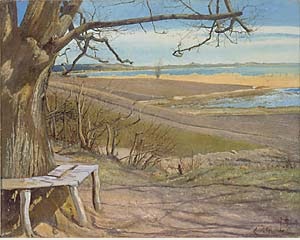To Edinburgh with an old friend to see the exhibition of Symbolist Landscape painting at the National Gallery which ends 13 Oct 2012. Edinburgh is where you go to see small, high quality and thoughtful exhibitions. I would go a long way to see a Hodler landscape - and there are two in this show: two Hammershøis and various other intensly interesting Scandinavian works. There were also an Angrand and a major Signac.There is a good Signac in Glasgow by the way. This show is built around some choice loans The most obvious is the Vision after the Sermon, the daddy of all symbolist landscapes.It will be shown at all three venues, which include Amsterdam and Helsinki. Edinburgh has two other Gauguins - one of them in this show.
So what is symbolist landscape painting? It is painting which seems to convey a meaning other than pure description - if there ever was such a thing.It may be concerned with mood - the state of the soul for example. It follows that to a post-romantic sensibility almost any landscape painting may qualify.The Gauguin blends both in a highly decorative way (he would not have refused the term). Human beings often do not figure largely in these works but their presence may be hinted at; for example by a light behind a curtain (Le Sidaner) In this exhibition Ring's painting
Lundbye's Bench at Lake Arresø shows a wooden seat under a tree - a seat frequented by a major landscapist. Van Gogh would have understood the symbolism - the empty chair-shades of Dickens/Fildes etc. But the subject is portrayed in an extremely naturalistic way and the symbolism is underplayed.That the idea of symbolist landscape can accomodate (if it can) Ring and Maurice Denis just shows how fluid a concept it is. It is one of the finest depictions of winter light that I know - the harsh clear light, possibly of March. It is a small jewel and in exquisite condition. Needless to say the Ordrupgaard website claims Ring, entirely reasonably, as a master of realism....which only goes to show that classification of paintings is in the mind of the beholder. Quite few of these works will be familiar from standard works on Scandinavian art. Prince Eugen's painting must be well travelled. So too the Jansson. You have to wonder how much the existence of an illustration predicts the choice of a work for exhibition - and/or the existence of appropriate custom made cases for transport.
Matisse's lumbering Luxe, Calme et Volupté is illustrated in the catalogue (not the slightest chance of it going on tour). As a subject it is no more radical than a work by Puvis, by whom there was one work present. I still find it strange that Puvis was so important to progressive artists of the 80s and 90s but that is the case.
There were many interesting groupings - a Whistler next to the Angrand next to the Signac in one room.This is because of the then contemporary fad of giving or grouping works with musical titles or associations. In another a Munch next to the Jansson next to a Hodler.And speaking of Jansson, when will we have an exhibition here? Paris had one in 1999 and the Musée d'Orsay acquired their Jansson in 2000.
The miserable grey green in the main hall - sorry, the Royal Bank of Scotland Room-may have harmonised with the paintings such as Prince Eugen's treescape but only deadened it.
The serene and fastidious solemnity of Hammershøi's painting of the Amalienborg certainly had a dreamy quality.
One treasure was the group of small temperas by Čiurlionis. These were abstracted designs based on memories of travel - including various lights seen and the sparks which steam trains emit from their fireboxes. I liked them very much for their spontaneity. I'm not sure if I would like his bigger, more elaborate works so much.Those seem to anticipate aspects of futurism and art deco in some ways but are themselves sui generis.What a pity they are not shown in the catalogue.You can see them here -though the colour seems a little exaggerated.
Regarding Hodler we must congratulate Edinburgh on being able to produce an example for this exhibition. I don't think there are any Hodlers in Helsinki or Amsterdam.The acquisition of this one for Edinburgh must be due to the imagination of Douglas Hall, the founder keeper of the SNGMA. Just to check things out I looked at the Tate website and of course they do not have a Hodler. Indeed the SNGMA website makes the reasonable claim that it is almost certainly the only Hodler in the UK. Nor does Tate have a Signac either.The Signac landscape at the National Gallery is a loan. A black mark for Rothenstein/Reid/Bowness era. So too for Serota who has been around a long time though working within Thatcherite budgets. Nowadays a Hodler would be placed with the National Gallery in London. Very few major galleries can get one but there are three Hodlers in the Musée d'Orsay and the Tate never really got started.No Angrand in the National Gallery or Tate.

No comments:
Post a Comment